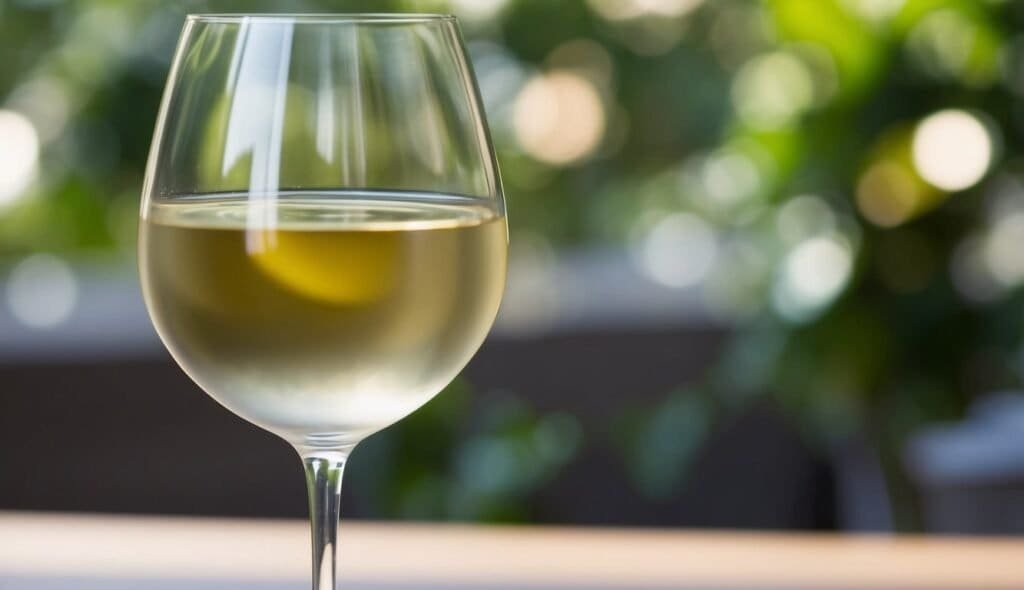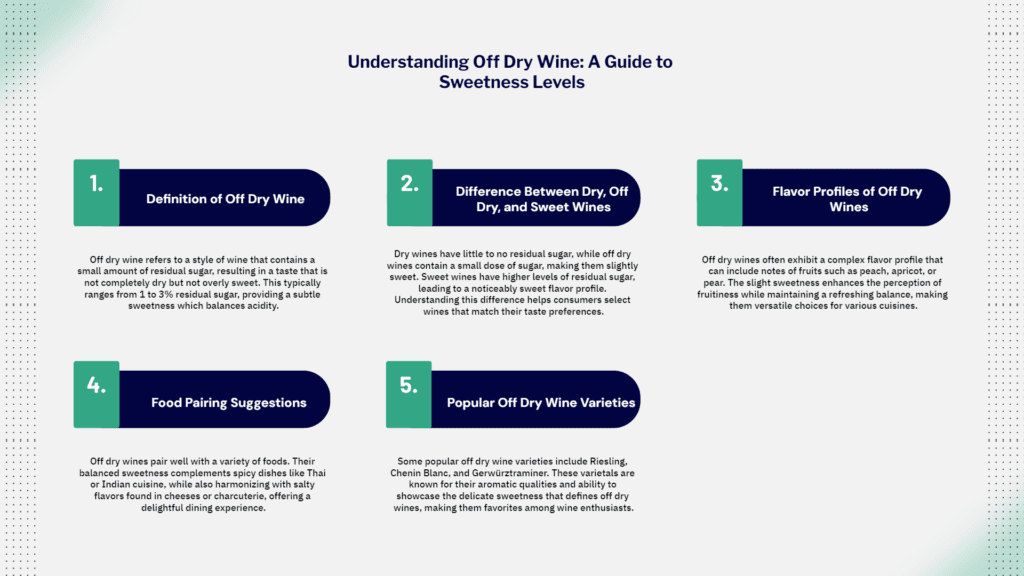This post may contain affiliate links. Please read my disclosure policy.
Have you ever sipped a wine that wasn’t quite dry but not exactly sweet? That’s off-dry wine. Off-dry wine has a touch of residual sugar, falling between dry and sweet on the sweetness scale. You’ll find it has a gentle sweetness that makes it easy to drink. What does off dry wine mean?
Off-dry wines are made when winemakers stop fermentation before all the grape sugar turns into alcohol. This leaves a bit of sweetness behind. You might enjoy off-dry wines if you’re not keen on bone-dry or very sweet wines. They offer a nice balance that many people find pleasant.
Australian Rieslings are great examples of off-dry wines. You can pair them with spicy Thai food or enjoy them on their own. Other Aussie varietals like Semillon can also be off-dry. Next time you’re at a bottle shop, why not try an off-dry wine and see what you think?
Understanding Wine Sweetness Levels

Wine sweetness varies greatly, affecting taste and food pairings. The amount of sugar left after fermentation plays a key role in determining a wine’s sweetness level.
Spectrum of Sweetness in Wine
Wine sweetness ranges from bone dry to very sweet. Dry wines have little to no sugar, while sweet wines can be quite sugary. Off-dry wines sit in the middle, with a hint of sweetness.
You’ll find dry wines like Shiraz and Chardonnay at one end. In the middle are off-dry wines such as some Rieslings. At the sweet end, you’ll encounter dessert wines like Muscat.
The sweetness level affects how you taste the wine. Dry wines may seem more tart, while sweet wines can mask other flavours.
The Role of Residual Sugar
Residual sugar is the natural grape sugar left after fermentation stops. It’s measured in grams per litre (g/L).
• 0-9 g/L: Dry
• 10-18 g/L: Off-dry
• 18-45 g/L: Medium sweet
• 45+ g/L: Sweet
Winemakers control sweetness by stopping fermentation early or adding sugar later. The amount of residual sugar greatly impacts a wine’s taste and mouthfeel.
Off-Dry vs Dry Wines
Off-dry wines have a touch of sweetness, while dry wines lack noticeable sugar. Off-dry wines contain about 10-18 g/L of sugar. This slight sweetness balances acidity and adds body.
You might enjoy off-dry Semillon or Verdelho. These wines pair well with spicy food or light desserts. Dry wines like Sauvignon Blanc or Cabernet Sauvignon suit savoury dishes better.
Tasting both types side by side can help you spot the difference in sweetness.
Acidity and Balance
Acidity plays a crucial role in balancing wine sweetness. It cuts through sugar, making wine taste less sweet than it is. High acid wines can handle more sugar without tasting overly sweet.
In sparkling wines, acidity affects sweetness perception. A ‘Brut’ sparkling wine might taste dry despite having up to 12 g/L of sugar due to high acidity.
You’ll find this balance in many Australian Rieslings. They often have high acidity and a touch of sweetness, creating a harmonious taste.
Common Varietals and Styles

Off-dry wines offer a range of options from popular varietals to distinctive regional styles. You’ll find a balance of sweetness and acidity that suits many palates.
Popular Off-Dry Wines
Riesling is a top choice for off-dry wines. Australian Rieslings from Clare Valley often have a touch of sweetness. Gewürztraminer is another grape that shines in the off-dry style. Look for Gewürztraminer from Tasmania for a local twist.
Chenin Blanc can be made in various styles, including off-dry. Try a Chenin Blanc from Western Australia for a fruity, semi-sweet experience. Moscato is known for its sweetness, but you can find off-dry versions too. Victorian Moscato often strikes a nice balance.
Wine Styles Across Regions
While Germany and Austria are famous for off-dry wines, Australia has its own offerings. The Hunter Valley produces some lovely off-dry Semillon. This style showcases the grape’s citrus notes with a hint of sweetness.
In cooler regions like Tasmania, you’ll find off-dry sparkling wines. These bubbly treats often use Chardonnay and Pinot Noir grapes. They’re great for celebrations or pairing with desserts.
South Australia’s Barossa Valley makes off-dry Viognier. This wine style highlights the grape’s floral aromas and stone fruit flavours. It’s a unique alternative to more common off-dry options.
Pairing and Serving Off-Dry Wines

Off-dry wines offer great versatility when it comes to food pairings and serving options. Their balanced sweetness and acidity make them suitable for a range of dishes and occasions.
Food Pairing Ideas
Off-dry wines shine when paired with spicy foods. The slight sweetness helps cool the heat, making them perfect for Asian cuisine. Try a Riesling from Clare Valley with Thai curries or Szechuan dishes.
Seafood is another great match. An off-dry Semillon from Hunter Valley pairs well with grilled prawns or fish tacos. The wine’s subtle sweetness complements the seafood’s natural flavours.
For cheese platters, reach for an off-dry Gewürztraminer from Adelaide Hills. Its aromatic profile and touch of sweetness work wonders with mild cheeses and fruit.
Don’t forget desserts. A late-harvest Viognier from Yarra Valley can be lovely with fruit-based puddings or tarts.
Serving Temperature and Glassware
Serving off-dry wines at the right temperature is key to enjoying their full flavour profiles. Chill these wines more than you would dry whites, but don’t serve them ice-cold.
Aim for 7-10°C for most off-dry styles. This temperature range preserves the wine’s freshness while allowing its aromas to shine.
For glassware, choose a tulip-shaped white wine glass. This shape concentrates the wine’s aromas and directs them to your nose.
When pouring, fill the glass only about one-third full. This leaves room for swirling, which releases the wine’s bouquet.
Remember to let the wine warm slightly in the glass. As it does, you’ll notice how its flavours and aromas evolve.
Frequently Asked Questions
Off-dry wines offer a unique balance between sweetness and dryness. Let’s explore some common questions about this intriguing wine style.
What distinguishes an off-dry wine from a sweet wine?
Off-dry wines have a hint of sweetness, but less than sweet wines. They contain 10-30 grams of sugar per litre. Sweet wines have more sugar and taste noticeably sweeter.
How does off-dry compare to semi-dry in winemaking?
Off-dry and semi-dry are the same thing in wine terms. Both refer to wines with a touch of sweetness. These wines fall between dry and sweet styles on the sweetness scale.
Can red varieties also be classified as off-dry, and if so, which ones?
Yes, some red wines can be off-dry. Aussie examples include certain Shiraz and Grenache styles. These reds may have a touch of sweetness balanced by tannins and acidity.
In what ways do off-dry Rieslings differ from their dry counterparts?
Off-dry Rieslings have more residual sugar than dry versions. This gives them a softer mouthfeel and slight sweetness. Aussie off-dry Rieslings often show riper fruit flavours.
What terroir influences result in off-dry characteristics in wine?
Cool climates can lead to off-dry styles. In Australia, regions like Tasmania and the Adelaide Hills produce grapes with the right sugar-acid balance for off-dry wines.
Could you list some popular off-dry white wines commonly available?
Popular Aussie off-dry whites include some Rieslings from Clare Valley and Eden Valley. You might also find off-dry Semillon from Hunter Valley or Gewürztraminer from Tasmania.
User Review
( votes)Sip smarter, subscribe now!
Subscribe for gourmet tips, event updates, travel ideas, and a free e-book on Food Pairings. Start your journey to culinary and travel excellence!













